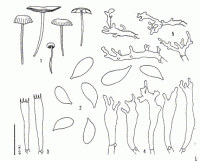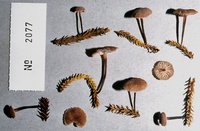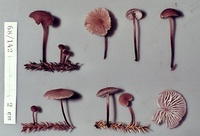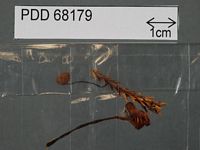|
 Marasmius rimuphilus Marasmius rimuphilus
BiostatusPresent in region - Indigenous. Endemic
Images (click to enlarge)
Caption: Fig. 19 (1-5). Marasmius rimuphilus Desjardin & E. Horak (PDD, holotype).- 1. Basidiomes.- 2.
Basidiospores.- 3. Basidia.-4. Cheilocystidia 5. Pileipellis. | 
Caption: ZT2077
Owner: E. Horak: © Creative Commons Attribution-Noncommercial 3.0 New Zealand | 
Caption: ZT68-142, Holotype
Owner: E. Horak: © Creative Commons Attribution-Noncommercial 3.0 New Zealand | 
Caption: Dried type specimen
Owner: Herb PDD | |
Article: Desjardin, D.E.; Horak, E. (1997). Marasmius and Gloiocephala in the South Pacific Region: Papua New Guinea, New Caledonia, and New Zealand taxa. Bibliotheca Mycologica 168: 152 p.
Description: Pi1eus 5-25 mm diam, hemispherical to convex when young, expanding in age to planoconvex
with a depressed to subumbilicate or rarely obtusely umbonate disc; margin striate to subplicate,
decurved, sometimes uplifted in age; surface dull, dry, minutely velutinous to granular-micaceous; disc umber brown with a reddish brown tone, paler towards the margin. Texture
membranaceous, cartilaginous-tough; context thin.- Lamellae broadly adnate to subemarginate,
subdistant (16-18) with 2 series of lamellulae, often anastomosing, broad (1.0-2.5 mm), whitish
to pale beige; edges even to subfimbriate, concolorous.Stipe10-30(-35) x 1.0-1.5 mm, central,
cylindrical, equal or gradually tapering towards the base, dull, dry, fistulose, tough-cartilaginous,
pruinose to coarsely floccose overall; apex pale brown, base dark brown; rhizomorphs absent.-
Odor and taste not distinctive.
Basidiospores 7-9(-11) x (3.0-)3.5-4.5 µm, narrowly ellipsoid to subcylindrical, smooth, thin-walled, hyaline, inamyloid.- Basidia 30-40 x (4)5-7 µm , cylindrical to subclavate, 4-spored,
clamped.- Cheilocystidia abundant, 20-40 x 5-14 µm, polymorphic, cylindrical, clavate or irregular
in outline, hyaline, thin-walled, with scattered apical to subapical diverticula 3-12 x 2-4 µm, knob-like or irregular in outline, sometimes lobed, hyaline.Pleurocystidia absent.- Pileipellis aRameales-structure with suberect to erect terminal cells, 20-50 x 5-15 µm, clavate or irregular in outline, often
lobed, smooth or with scattered diverticula, brown-incrusted, weakly to strongly dextrinoid;
diverticula 3-10 x 2-5 µm, knob-like to irregular in outline, obtuse, often forked, brown.- Pileal and
1amellar trama weakly dextrinoid, non-gelatinous.- Stipe t issue monomitic, strongly dextrinoid.-
Cau1ocystidia numerous, 25-80 x 5-12 µm , polymorphic, similar to terminal cells of pileipellis,
cylindrical to irregular in outline, with or without knob-like diverticula, thin-walled to moderately
thick-walled, pale yellowish brown, dextrinoid or inamyloid.- Clamp connections present.
Habitat: Habit, habitat and distribution.- Solitary, in groups on rotting needles and twigs of Dacrydium
cupressinum (Podocarpaceae), rarely also on leaves of Weinmannia racemosa (Cunoniaceae). New
Zealand.
Notes: Diagnostic features of M. rimuphilus include: a relatively large, umber brown, subplicate pileus;
subdistant, white, non-marginate lamellae; a pruinose to floccose, dark brown, insititious stipe
lacking rhizomorphs; pileipellis composed of a well-developed Rameales-structure; dextrinoid
tissues; diverticulate cheilocystidia and caulocystidia; and growth on debris of rimu (Dacrydium
cupressinum). Marasmius rimuphilus may be the taxon reported by Colenso (1886) as M.
androsaceus (L. : Fr.) Fr., a common temperate Northern Hemisphere species. Marasmius
androsaceus differs, however, in forming a glabrous stipe lacking conspicuous diverticulate
caulocystidia, forms numerous black rhizomorphs and fewer lamellae (8-17). Other taxa with darkly
pigmented pileus and pruinose stipe include M. hakgalensis Petch from Sri Lanka, South America
and Zaire (Isotype, FH!), M. thiersii Desjardin from western North America (Holotype, SFSU!), and
M. cryptotrichus Singer from Mexico (Holotype, F!). All of the latter taxa differ from M. rimuphilus
in forming fewer lamellae, black rhizommophs, and cylindrical, non-diverticulate, thick-walled and
longer caulocystidia.
|